
Hevea is a genus of flowering plants in the spurge family, Euphorbiaceae, with about ten members. It is also one of many names used commercially for the wood of the most economically important rubber tree, H. brasiliensis. The genus is native to tropical South America but is widely cultivated in other tropical countries and naturalized in several of them. It was first described in 1775.

Jepsonia is a small genus of flowering plants containing three species. The Jepsonia is a perennial with a cormlike caudex, toothed leaves, and a cyme inflorescence that blooms in the fall. Jepsonia plants are native to California and Baja California.

Horkelia californica, known by the common name California horkelia, is a species of flowering plant in the rose family.
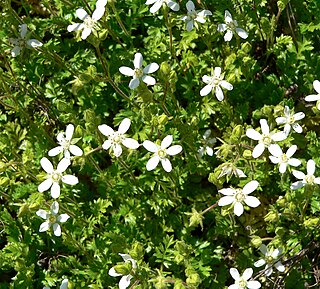
Horkelia parryi is a species of flowering plant in the rose family known by the common name Parry's horkelia. It is endemic to California, where it grows in the chaparral of the Sierra Nevada foothills. This is a low, mat-forming perennial herb growing in unobtrusive green patches on the ground. The leaves are 5 to 10 centimeters long and are each made up of small, toothed, oval-shaped leaflets. The somewhat hairy green to reddish-green stems are 10 to 30 centimeters long and bear inflorescences of a few flowers each. The flower has minute bractlets under larger, pointed sepals and five white petals. The center of the flower contains a ring of stamens around a patch of up to 50 thready pistils.
Jepsonia malvifolia is an uncommon species of flowering plant in the saxifrage family known by the common name island jepsonia. It is found only on the Channel Islands of California and Guadalupe Island off Baja California. It grows in exposed rock and clay soils on the chaparral and scrub slopes of the islands. This is a small perennial herb producing two or three leaves from a flat caudex. The green leaves are round or kidney-shaped and edged with ruffled lobes. The plant flowers in fall, producing an inflorescence on a tall peduncle. The tiny flowers have red-veined white, yellowish, or pinkish petals. The fruit is a tan-striped greenish capsule.

Jepsonia parryi is an uncommon species of flowering plant in the saxifrage family known by the common names coast jepsonia and Parry's jepsonia.
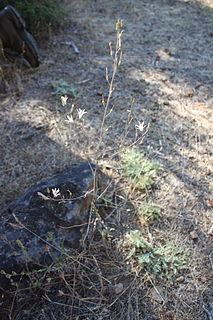
Chlorogalum angustifolium is a species of flowering plant, known by the common name narrowleaf soap plant.
Eryngium pinnatisectum is an uncommon species of flowering plant in the family Apiaceae, known by the common names Tuolumne eryngo and Tuolumne button celery.
Lithophragma bolanderi is a species of flowering plant in the saxifrage family known by the common name Bolander's woodland star. It is endemic to California, where it is known from several mountain ranges, including the North Coast Ranges, the foothills of the Sierra Nevada, and the San Gabriel Mountains. It grows in many types of open habitat. It is a rhizomatous perennial herb growing erect or leaning with a tall naked flowering stem. The leaves are located on the lower part of the stem, each divided into rounded lobes. The stem bears up to 25 flowers, each in a cuplike calyx of red or green sepals. The five petals are white, under one centimeter long, and toothed or smooth along the edges.
Monardella candicans is a species of flowering plant in the mint family known by the common name Sierra monardella.
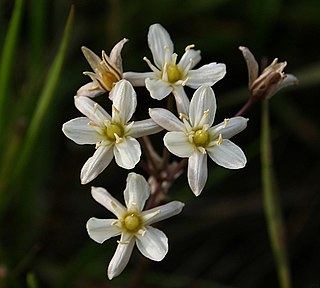
Muilla maritima is a species of flowering plant known by the common names sea muilla and common muilla. It is native to California and Baja California, where it grows in many types of habitats from the coast to the Mojave Desert and Sierra Nevada foothills and other inland mountains, in grassland, woodland, desert, and forest floras. It is a perennial plant growing from a corm and producing an erect flowering stem up to half a meter tall. The onion-like leaves at the base of the stem may be 60 centimeters long. The flowering stem bears an umbel-shaped array of many flowers on pedicels up to 5 centimeters long. Each flower has six tepals which are green-tinged white in color with brownish midribs and no more than 6 millimeters in length. At the center of the flower are six erect stamens with blue, green, or purplish anthers.
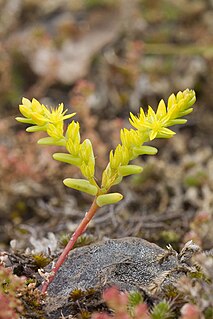
Sedella pumila is a species of flowering plant in the family Crassulaceae known by the common name Sierra mock stonecrop. It is native to California, where it grows in the North Coast Ranges and adjacent sections of the Central Valley to the Sierra Nevada foothills. It is a plant of vernal pools and similar habitat, growing in rocky and gravelly flats of serpentine soils, limestone, and soils of volcanic origin, often alongside mosses. This is an annual herb growing 2 to 17 centimeters high, in shades of green, yellow, and red. It has small knobby succulent leaves each a few millimeters long. The flowers atop the threadlike stems have fleshy sepals and yellowish petals a few millimeters in length. The flowers have a musty scent.
Pseudobahia heermannii is a species of flowering plant in the aster family known by the common names foothill sunburst and brittlestem.
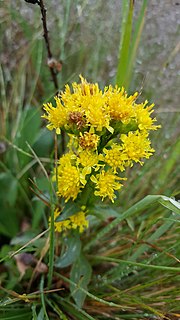
Senecio aronicoides is a species of flowering plant in the aster family known by the common name rayless ragwort. It is native to Oregon and northern and central California, where it can be found in the woodlands and forests of mountains and foothills, often in relatively dry habitat. It is a biennial or perennial herb growing up to about 90 centimeters tall from a fleshy root attached to a buttonlike caudex. The plant is often slightly woolly or cobwebby in texture. The leaves have lance-shaped to oval blades measuring up to 20 centimeters long, the largest ones lower on the stem. The inflorescence is a corymb which is flat and spreading, often resembling an umbel. The flower heads are cups lined with black- or green-tipped phyllaries and filled with many gold disc florets. There are usually no ray florets but one or two occasionally emerge from a head. The fruit is a hairless achene tipped with a pappus of long, white bristles.
Packera clevelandii is an uncommon species of flowering plant in the aster family known by the common name Cleveland's ragwort. It is endemic to California, where it is known from only two small regions, a section of the North Coast Ranges around Napa County and a part of the Sierra Nevada foothills on the opposite side of the Sacramento Valley. The plant grows in shrubby chaparral, often on serpentine soils.
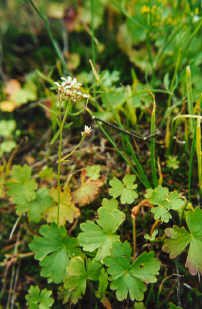
Suksdorfia ranunculifolia is a species of flowering plant in the saxifrage family known by the common name buttercup suksdorfia. It is native to western North America from British Columbia and Alberta south to northern California. It grows in moist, rocky habitat in mountains and foothills. It is a non-rhizomatous perennial herb growing up to 40 centimeters tall. The leaves have rounded blades up to 4 centimeters wide with several large lobes edged with rounded teeth. The blades are light green, slightly fleshy, hairless in texture, and are borne on petioles up to 15 centimeters long. The inflorescence is a dense, flat-topped cluster of up to 35 flowers borne atop a mostly naked, hairy, glandular stalk. Each flower has a bell-shaped calyx of pointed sepals and five white or pink-tipped petals. The fruit is an oval brown capsule measuring 4 millimeters in length.
Frasera tubulosa is a species of flowering plant in the gentian family known by the common name Kern frasera.

Toxicoscordion paniculatum is a species of flowering plant known by the common names foothill deathcamas and sand-corn. It is widely distributed across much of the western United States, especially in the mountains and deserts of the Great Basin region west of the Rocky Mountains. It grows in many types of habitat, including sagebrush plateau, grasslands, forests, and woodlands, etc.

Persoonia cuspidifera is a species of flowering plant in the family Proteaceae and is endemic to northern New South Wales. It is an erect shrub with spatula-shaped leaves and greenish yellow, tube-shaped flowers in groups of up to twenty-five.

Protea angustata, also known as the Kleinmond sugarbush, is a flowering shrub that belongs to the genus Protea. This plant is endemic to the south-west Cape Region of South Africa.











